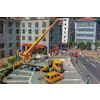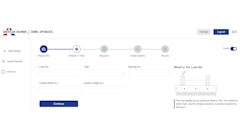Although materials costs continued to accelerate in May, they may be about to hit the brakes. That’s what futures markets and price reporting services are signaling, according to the Associated General Contractors Chief Economist Ken Simonson.
The Bureau of Labor Statistics reported on June 14 that the producer price index (PPI) for inputs to construction—a weighted average of the cost of all materials used in every type of project, plus items consumed by contractors, such as diesel fuel—climbed 0.9%, not seasonally adjusted, from April to May and 7.5% over 12 months. The year-over-year increase has risen steadily since January, when it totaled 5%.
But one of the biggest contributors to the May-to-May increase was diesel fuel, which soared almost 40%. Since the data were gathered for computing the May PPI, diesel prices have fallen about 15 cents per gallon, according to the Energy Information Administration (EIA)’s weekly survey of 350 truck stops. Further decreases seem likely, as the price of crude oil—the major determinant of diesel prices—has come down as much as $18 per barrel, or more than 40 cents per gallon. On June 7, EIA lowered its projections for 2011 average prices in its monthly Short-Term Energy Outlook.
Copper futures have retreated more than 10% from their peak in early February. Yet the PPI for copper and brass mill shapes has dropped only 7.5% over the past three months, suggesting that further declines are in the offing.
The PPI for gypsum products climbed 4.3% in May alone and 6.2% over three months. But demand for building construction remains very weak, making it likely that the price increases will erode soon, as they did after gypsum makers pushed through big increases in March and May 2010. In fact, even after the recent increase, the PPI for gypsum products was 1.2% lower than a year ago.
Steel prices have been on a seesaw for the past few weeks, according to reporting services, with some products up one week and down another, while other products follow the opposite pattern. Although the PPI for steel mill products (which includes automotive and appliance steel as well as construction materials) rose 1.1% in May and 10.1% over 12 months, future changes are likely to be smaller—and not all to the upside.
At this point in the year, it appears the yearend change in the construction PPI will be closer to the 5.3% increase that occurred from December 2009 to December 2010 than to last month’s 7.5% rise. Unfortunately, that will still be tough on a lot of contractors, because their bid prices—as reflected in the PPIs for finished buildings—have been inching up only 1 to 2% per year. Those gains are unlikely to accelerate until demand for construction rises and the number of contractors competing for work falls.












![Fcp Racatac Chair 10893876[1]](https://img.forconstructionpros.com/mindful/acbm/workspaces/default/uploads/2025/10/fcp-racatac-chair-108938761.10l0At5WXv.png?ar=16%3A9&auto=format%2Ccompress&bg=fff&fill-color=fff&fit=fill&h=135&q=70&w=240)

